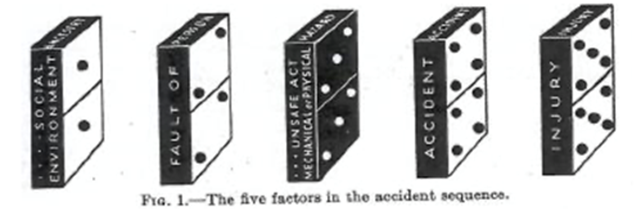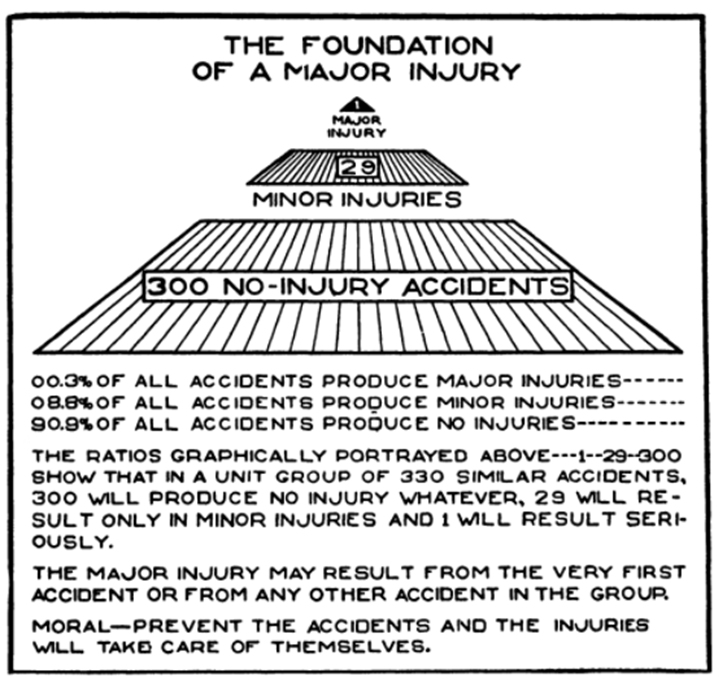Zero as a Semiotic
When we look at the image (semiotic) of zero there is much that is going on unconsciously.
The idea of zero in risk and safety may have originally started as some naïve quest for no injuries but it has evolved to become the iconic anchor for a religious movement. The Spirit of Zero video (https://www.youtube.com/watch?v=_VIRXEuniWA ) released in 2021 prior to the zero convention in Spain May 2021 cements zero ideology as the religious semiotic for the zero vision movement (safety).
We can trace the semiotic of zero all the way back to the numerics, pyramid and domino semiotics of Heinrich (1931). Heinrich’s semiotics still plague the risk and safety industry with their mechanistic assumptions, linearity and numeric attributions. Neither semiotic bias nor model bias are named in any of Heinrich’s work or in the risk and safety industry. The assumptions about how models and symbols are presented in the risk and safety industry is that semiotics are somehow neutral and objective, just the representations of a metaphoric/symbolic reality. Nothing could be further from the truth.
What Heinrich’s dominoes embed unconsciously is that causality is: methodical, linear, sequential and not contingent. Indeed, causality even runs from left to right for Heinrich (see Figure 1). The swiss-cheese semiotic introduced later by Reason attributes the same characteristics to causality.
Figure 1. Heinrich’s Dominoes
Heinrich’s pyramid semiotic embeds unconsciously that causality is: hierarchical, ratio measured and numeric. All these attributions are exactly that – attributions, there is ample evidence to argue that causality is: chaotic, non-linear, ‘wicked’ and emergent. Indeed, when considering humans as an ecology, there is no evidence for Heinrich’s semiotic validity. The real world of biosemiotics demonstrates that Heinrich’s semiotics are off with the fairies.
What is hidden in Heinrich’s semiotics (Figure 2. Heinrich’s Pyramid) are assumptions about: determinism, materialism, epistemology and naive realism. These philosophical assumptions are never owned by Heinrich or the industry that follows his false consciousness.
What we know from the study of semiotics is that signs and symbols hide philosophical assumptions from the undiscerning eye. Semiotics are absorbed unconsciously and tacitly (Polanyi) and without semiotic critique, embed their hidden philosophy by osmosis. Without a semiotic worldview, one is unlikely to understand the power of semiotics in shaping the human unconscious. In order to understand semiotics one needs to know that humans live in a semiosphere not just a biosphere. (Semiotics has now become the most demanded study in the Centre for Leadership and Learning in Risk (https://cllr.com.au/).
Lotman defines the semiosphere as:
… that synchronic semiotic space which fills the borders of culture, without which separate semiotic systems cannot function or come into being.
Semiotics have a force and power unto themselves and influence the unconscious like an archetype. All semiotics emerge from a semiosis (an ontology of meaning and purpose). One’s semiosis (symbolic/myth meaning) drives the hidden philosophy behind one’s choice of semiotic. No image is neutral or objective but is situated within the semiosphere, generated by a philosophy hidden in the semiotic. All signs and symbol systems work this way.
Figure 2. Heinrich’s Pyramid
When we speak of the power of semiotics we might like to think of the power of a crucifix or a swastika and contemplate just what power these symbols have as a ‘force’ in history. Display either symbol and see what they invoke. There is need not be any text, no audible comment, no narrative, no descriptive discourse, the symbol operates and triggers emotions, ideologies and responses all on its own. As we know about all tacit knowing, semiotics holds a force well beyond itself, this is what the power of a symbol/myth generates. The symbol/myth embodies the ideology of a movement and without it, identity is lost. What is a bikie gang without its symbols?( https://www.abc.net.au/news/2013-10-04/bikie-gangs-by-colours/4999510 ) What is the masonic lodge without its symbols? (https://www.ghlilley.com.au/blogs/news/freemason-symbols ). What is Qanon without its symbols of hate? (https://www.timesofisrael.com/a-guide-to-the-hate-symbols-and-signs-on-display-at-the-us-capitol-riots/ ). Just imagine if you could rid safety of its nonsense symbols like: risk matrices, pyramids, swiss-cheese, bow-ties and curves? (https://safetyrisk.net/all-risk-is-subjective/ ).
However, when your worldview (philosophy) is even unknown to oneself, how would one know what philosophy is being promoted by such semiotics as Heinrich developed? When one assumes that semiotics are objective and neutral one is surely in for a hiding of one’s own creation. This is how Safety ends up claiming religious efficacy in a symbol.
It’s hard to envision risk (https://www.humandymensions.com/product/envisioning-risk-seeing-vision-and-meaning-in-risk/ ) when one only knows one worldview and then deems this worldview as authoritative and objective. This is what Safety claims with its supposed ethic of risk in the AIHS BoK Chapter 38.3. Just because the safety worldview declares something as objective doesn’t make it so. Such is the nature of Safety’s deontological ethic and naïve realism. This is the same kind of naivety claimed by observation that the sun revolved around the earth.
Now to the semiotics of Zero. Zero is not just a number but has a long history of semiotic power. A simple reading of Kaplan (1999) The Nothing That Was, A Natural History of Zero (https://sites.google.com/site/bilji22ocmae1/8OoO1wOp5630 ) demonstrates how this object holds ideological and tacit power. Or read Seife (2000) Zero, The Biography of a Dangerous Idea (https://fdocuments.in/document/zero-the-biography-of-a-dangerous-ideaby-charles-seife.html ). The development of zero as the semiotic representation of place/infinity was a philosophical/methodological creation.
The semiotic representation of nothing, null, void and infinity in an object continues to foster philosophical argument about the nature of the cosmos (https://www.researchgate.net/publication/345673605_The_Explanation_for_Dark_Matter_and_Dark_Energy ). Zero is neither a neutral or objective concept.
The semiotic worldview is not a mechanistic worldview. There are other valid worldviews other than the Safety worldview (https://safetyrisk.net/starting-points-worldviews-and-risk/ ; https://safetyrisk.net/transdisciplinarity-and-worldviews-in-risk/ ; https://safetyrisk.net/a-poetic-worldview/ ; https://safetyrisk.net/can-there-be-other-valid-worldviews-than-safety/ ; https://safetyrisk.net/the-mechanistic-worldview-and-the-dehumanisation-of-risk/ ). The projection of a mechanistic worldview of objects and observable objectivity is the fantasy of Safety. This is how Safety ends up promoting videos on normalising spiritual healing via zero.
The semiotic of zero drives an ideology, whether one understands it or not. It is not likely that such an engineering (safety) worldview could work out how it ends up with a religious/theological video on spiritualism from a base of a zero semiotic. (https://www.youtube.com/watch?v=_VIRXEuniWA). How strange this industry confused by its own metaphysics and doesn’t even know it.
Without some level of respect for other worldviews in Transdisciplinarity it is not likely that Safety will even realise how religious it has become, even when it claims its own form of soteriology. Only high priests in Safety could claim ‘safety saves’.
Similarly, when one accepts as the starting point of safety on the semiotics of Heinrich one need not wonder why this risk and safety industry is bogged down in a psychosis of numerics, metrics and blame. The driving assumption behind Heinrich’s semiotics are also the driving semiotics of zero. The strange thing about this religious journey is the denial of fallibility as its endpoint. What kind of philosophical gymnastics does one have juggle to get to end up in such delusion?
Such is the binary naivety of an industry that sets its identity by zero ideology and Heinrich’s false consciousness. When zero takes over, all critical thinking ceases, such is the semiotic power of zero.





Rob C says
Hi Rob, yes the attraction of a simple silver bullet certainly is anti human and at best ignorant. I find it equally awkward that both models are constantly misinterpreted and miscommunicated. For example Heinrich was an insurance engineer and so a simple dollar answer made some sense. Reasons Swiss cheese model is about understanding how the holes get in the cheese. All models are wrong, but some are useful.
Certainly a humanised approach to risk that acknowledges unconscious and social interaction and influences does not need to focus on a model. The challenge for health and safety, environment, security, quality and other risk based Trojans is how to shift the mindset of big corporations in a sustainable way, given the impact of sunk cost and traditional Newtonian thinking.
rob long says
I think Safety thinks models are not interpreted and yet hold power within themselves of fundamental philosophical value, regardless of interpretation. A reductionist model/semiotic can hardly be made and open model for conversation or listening. Numerics can’t be made into person-centerdness.
I don’t find any of the models in traditional safety even slightly helpful, all founded on the centrality of objects, numerics, hierarchies and linearity. Just imagine if Safety put persons first what kind of models might be in place.